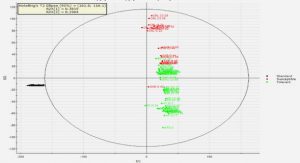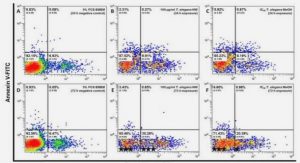Get Complete Project Material File(s) Now! »
Loxostylis alata A. Spreng. ex Rchb. Anacardiaceae
The name Loxostylis is derived from the Greek loxos meaning ‘crooked’ or ‘oblique’, and the Latin stylis for style, a reference to the lateral attachment of the style to the ovary. The common name tarwood presumably refers to the oily residue from the fruits. Tarwood is an evergreen, ornamental tree that grows to a height of 5 metres which is grown in cultivation in a wide range of ecological habitats, while naturally it occurs in rocky and forest areas along river banks. The leaves are alternate and compound with 2 to 5 pairs of leaflets, including a terminal leaflet. Typical of the species is the conspicuous winged rachis (midrib). The specific name is based on the Latin alatus meaning ‘winged’. Young leaves are red. The bark is pale grey and has vertical shallow fissures with latex present. The flowers are male or female on different trees and produced from November to February. The male flowers are white and pleasantly scented and the female flowers are greenish white. The petals of the female flowers fall soon, but their sepals enlarge substantially and turn pink-red, covering the developing fruit and creating a very attractive display. The fruits of L. alata are small, fleshy and measure about 4 mm in diameter, usually they are found embedded in the brightly coloured sepals. The seed skin contains a black sticky substance like tar; it is difficult to wash when touched (Coates-Palgrave, 2002).
The bark and leaves are widely used in South Africa as traditional medicine to relieve pain during childbirth particularly among the Zulu tribe (Pooley, 1993). Figure 2.13 shows the leaves and stem of Loxostylis alata.
Khaya anthotheca (Welm.) C.D.C. Meliaceae
The plant is commonly called east African mahogany. Khaya anthotheca is a large evergreen tree up to 60 m tall (up to 30 m in the garden) with an elongated or rounded, much-branched crown; the trunk is buttressed in old specimens. The bark on the young branches is smooth and greyish brown but smooth to sometimes mottled grey and brown, flaking on the older branches and stems. Leaves are alternate, evenly compound with 3–7 pairs of leaflets, 150–300 mm long and dark glossy green, base broadly tapering to round and slightly asymmetric, smooth and glossy, veins distinct on the lower surface, margin smooth.
Flowers appear in branched sprays at the tips of branches, are white and sweetly scented, up to 10 mm in diameter, the male and female flowers are separate but on the same tree, and the stamens join to form a tube up to 6 mm long. The flowering period is from September to December. The fruit is a hard, woody, oval, splitting capsule up to 60 mm in diameter, with 4 or 5 valves. Fruiting occurs from March to September (Estherhuyse et al., 2001).
The wood weathers well and is resistant to borers and termites. It is moderately resistant to fungal decay.
The timber saws well but is inclined to be tough, and sharp equipment is therefore needed. The wood is dark, hard, reddish brown and durable, suitable for furniture, flooring, panelling, and excellent for boat building, moderately heavy the bark is bitter, similar to quinine, and is used for colds. Oil from the seed is rubbed into the scalp to kill insects (Estherhuyse et al., 2001). Figure 2.16 shows the leaves and stem of K. anthotheca.
Ochna natalitia (Meisn.) (Walp.) Ochnaceae
The common names for this plant are Cape plane, Transvaal boxwood, Rooihout and Ysterhout. The plant is a small to medium sized shrub measuring up to 10 meters in height, it occurs in bushveld and grassland, frequently in shallow soil among rocks. The bark is grey-brown or brown, finely fissured to rough. Young leaves have attractive coppery red colour and green when matured with numerous lateral veins that are close together. Flowers are yellow to golden yellow and have a diameter of 1.5-3 cm. The fruits occur in 2-3 druplets, ovoid and 5-10 mm long. The fruits are attached near base and are black in colour becoming red or spreading on recurved stalks (Coates-Palgrave, 2002).
Infusions of the root are taken traditionally to cure barrenness (Palmer and Pitman, 1972). The name isithundu refers to medicine used to bring prosperity (Doke and Vilakazi, 1972). Figure 2.19 shows the leaves and stem of Ochna natalitia.
Chapter 1: Introduction
1.1. Hypothesis
1.2. Justification of the study
1.3. Summary and problem statements
1.4. Objectives
Chapter 2: Literature review
2.1. Importance of poultry
2.2. Poultry production
2.3. Constrains to poultry production
2.4. Aspergillosis in humans and animals
2.5. Aspergillosis in poultry
2.6. Mycotoxicoses
2.7. Treatment of aspergillosis in birds
2.8. Antifungal drugs in common use and their mode of actions
2.9. Plants as antimicrobial agents
2.10. Fungal diseases and Inflammation
2.11. Resistance to antifungal agents
2.12. Plant species used in the study
2.13. Loxostylis alata A Spreng. ex Rchb Anacardiaceae
2.14. Protorhus longifolia (Bernh.) Engl. Anacardiaceae
2.15. Kirkia wilmsii (Engl.) Kirkiaceae
2.16. Khaya anthotheca (Welm.) C.D.C. Meliaceae
2.17. Commiphora harveyi (Engl.) Engl. Burseraceae
2.18. Combretum vendae (A.E. van Wyk) Combretaceae
2.19. Ochna natalitia (Meisn.) (Walp.) Ochnaceae
2.20. Conclusion
Chapter 3: Evaluation of several tree species for activity against the animal fungal pathogen Aspergillus fumigatus
3.1. Introduction
3.2. Materials and methods
3.3. Results and discussions
3.4. Conclusion
Chapter 4: Detection of antimicrobial compounds by direct bioautography of different extracts of leaves of selected South African plant species
4.1. Introduction
4.2. Materials and methods
4.3. Results and discussions
4.4. Conclusion
Chapter 5: Evaluation of selected South African plant species for antioxidant, antiplatelet and cytotoxic activity
5.1. Introduction
5.2. Materials and methods
5.3. Results
5.4. Discussion
Chapter 6: Preliminary screening of some fractions of Loxostylis alata (Anacardiaceae) for antimicrobial and antioxidant activities
6.1. Introduction
6.2. Materials and methods
6.3. Results and discussion
6.4. Conclusion
Chapter 7: Biological activities of two antifungal compounds isolated from Loxostylis alata (Anacardiaceae
7.1. Introduction
7.2. Materials and methods
7.3. Results and discussions
7.4. Conclusion
Chapter 8: A leaf extract of Loxostylis alata ( prevents experimental aspergillosis in chicks
8.1. Introduction
8.2. Materials and methods
8.3. Results
8.4. Discussion and conclusions
Chapter 9: General discussions and conclusions
9.1. Evaluate the antimicrobial activity of selected South African plant species
9.2. Isolate and characterise the compounds active against Aspergillus fumigatus from extracts of selected plant species
9.3. Determine the in vitro antimicrobial, antioxidant and anti-inflammatory and cytotoxicity activities of the extracts and isolated compound(s) of selected plant species
9.4. Evaluate the efficacy of the crude extract in vivo in a poultry model
9.5. Conclusions
Chapter 10: References
Chapter 11: Appendix






